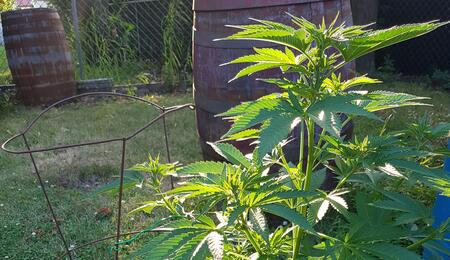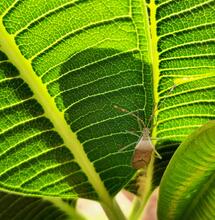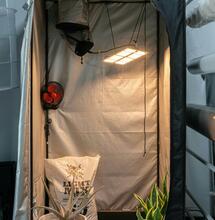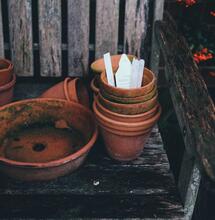Starting A Cannabis Grow Outdoors (Part 2)

As the Springtime approaches, cannabis growers are starting to prepare their outdoor garden for the growing season. In part one of this year's outdoor grow guides, we discussed starting your cannabis grow indoors, before planting them outdoors.
Outdoor Grow Guides 2020
In part 2, we will be covering what to do to start your grow outdoors with a seedling, or the plant that has been growing indoors, outdoors. So, whether you have started your growing indoors, or whether you plan to plant seeds outdoors, this guide will help get you off to the best start with your outdoor grow this year.
Starting a Cannabis Grow Outdoors
Once the cold of Winter has passed, and you move into Spring, the conditions outdoors begin to improve. Depending on where you live, this can be anything from mid-March, to early May, sometimes even June in colder climates. A cannabis seedling is not very strong. A harsh environment can easily kill it. Also, because it is so small, it can easy be eaten by bugs or animals. You not only have to protect your plants from the cold, but also from the wildlife, crooks, and in some cases the cops. When the last frost has passed, and the conditions outdoors start to improve, you can plant your seedling outdoors. But to ensure the plants survival, there are some precautions you should take. Also, you need to take into consideration how good the soil you are planting into is. Does it have enough nutrients in it? Does it have good drainage? The better quality the soil is, the happier your plant will be. So, to begin growing outdoors, you need to set up an area, and make sure it is ready for your plants to move into.
Setting up Your Outdoor Grow Space
Lighting is important to a cannabis plant, not just when it gets light, but when it doesn't. For a photoperiod cannabis plant to flower it needs to have around 12 hours of day, and 12 hours of night. If a cannabis plant receives irregular light during its night cycle, the plant can hermaphrodite (grow male and female flowers), "re-veg" (revert back to the vegetative stage) or not flower at all. For best results, you should find a place for your plant, that gets a lot of sunlight during the day, but no light at all during night. This can be street lights, cars driving by, the lights from your house. Any light, stronger than a full moon, has the potential to "hermie" or "re-veg" your plant. So, choose your location wisely to ensure the night cycle will not be disturbed. Of course, a cannabis plant is a valuable crop. Even if you are growing legally, secrecy is important! If the wrong person finds out about your plant, it may be stolen. It can be difficult to hide a cannabis plant if it grows to its full height. Secrecy is very important to your safety, try and grow your plant in a place where no one else will see it. Airflow is also important! Don't plant your plants too close to a fence, or wall. During flower, if the plant isn't getting enough air flow around the buds, they can get bud rot, or powdery mildew, and this will ruin your whole crop. Make sure air can flow around your whole plant easily.
Dig a Hole, and Fill it with Soil
Give your plant a good amount of root space. Start off by digging a hole, about 50L in volume, and fill it with good soil. There are many brands you can choose from, and it is readily available at most garden centers and shops. It is also very cheap. A good soil will feed your plants for weeks, and maybe even months, without you having to add any extra nutrients. All your plant will need is water.
Plant Your Seed, or Plant
If you started your cannabis grow indoors, then it is recommended you acclimate your plant slowly to the outdoor conditions. You can do this by bringing the plant outdoors for just a couple of hours a day, and slowly extending the amount of time it is left outdoors, by a couple of hours each day. After a week, your plant should be ready to live outside. When the plant is ready, dig your hole, fill it with your preferred soil, and transplant the plant from the pot, into the ground. To do this, simply bury the plant and the pot, but leave about a centimeter of the pot above the ground, this will make it easy to lift it back out. Lift the pot out and you will be left with a perfectly shaped hole for your plant's roots. Take the plant out of the pot, and place the plant into the hole. It will fit perfectly, and she is ready to live outdoors. If you're starting from seed, planting your seed straight into a strong soil, may kill it. Too much food in the soil can shock the tap root as it comes out of the shell. To prevent this, after filling the hole with soil, you should make a smaller hole in the center of the new soil. Fill that hole with around 3L of "potting mix". This will be much more suitable for a seedling. As the plant grows and the roots expand, they will make their way into the stronger soil, where plenty of nutrients are available. Once planted, water around the plant/seed to fully saturate the soil around it. Then, you let nature take its course. If it doesn't rain for any longer than 4 days, you should water the plant yourself.
Protecting Outdoor Cannabis Plants From Animals
Depending on your location in the world, your plant will be at risk from different animals. From moles, deer's, rabbits, badgers, your plant can be eaten by many animals, especially when it is young. You can help prevent this by building an enclosure around the plant. Start off by covering the ground around your plant with a layer of chicken wire. This will help prevent animals from digging up through the ground to get to your plant. Prevention is better than cure. You can also build a small fence around your plant by using chicken wire or fencing. This will prevent animals from getting to your plant and eating it, or damaging it.
Protecting Outdoor Cannabis Plants from Bugs
It's going to be difficult to prevent bugs from getting to your plant. You can plant "companion" plants next to your cannabis plant. The most common companion plants are Garlic Chives, and Mint. These will confuse the bugs because of their strong odour, and they may leave your plant alone. You can also plant "Nasturtium". This plant will be a sacrificial plant that the bugs will eat instead of your cannabis plant. They will be more attracted to this than your plants. Nature will find balance. There are bugs that will eat your plants, but there are also bugs that will eat those bugs. A cannabis plant will have its own immune system and will be able to fight off some pests on its own too. Keep your plant healthy, and it will stand a better chance of fighting off pests and disease. Sprinkling some crushed egg shells across the top of your soil, is a great way to prevent slugs and snails getting to your plant. This can also add some extra calcium to the soil further into the grow as the egg shell gets broken down by the microbes.
Let it Grow!
That’s all you have to do! As long as you have a good location, and some good soil for your plant to live in, she will grow beautifully. You won't have to feed your plant for a while, if you're growing in "living soil" you may not have to feed them at all! If it rains often, you won't even have to water them. Depending on the time of year you plant outdoors, your plants could veg for months before they get to the flowering process. Your plant will be huge, and the bigger it is, the harder it will be to keep hidden. Some growers choose to grow "autoflowering" cannabis plants outdoors, as they will not grow as big, and they will be finished sooner than photoperiod plants. If you would like to know more about this, head to Percysgrowroom.com to check out my guide on " Growing Autoflowering Cannabis Plants Outdoors" Once your plant is in the ground, you just have to wait. It won't need feeding for a few weeks. Pick up the next issue of Soft Secrets, for some ideas on training your plants, and what to do during the vegetative stage. Thanks for reading everyone! Happy growing!



.png)